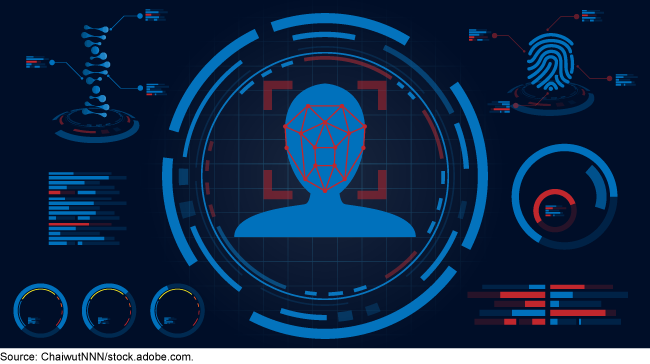Forensic Technology: Algorithms Offer Benefits for Criminal Investigations, but a Range of Factors Can Affect Outcomes
Fast Facts
Fingerprints and other physical evidence have long helped law enforcement officers solve crimes. Advances in forensic algorithms allow experts to partially automate the examination of such evidence.
Algorithms can analyze finger or palm prints, facial images, or DNA. We testified that these tools can improve speed and objectivity in many investigations.
But analysts and investigators face challenges such as possible bias and misuse, and difficulty communicating results.
Our prior work identified policy options that could help, including increasing transparency in how these algorithms are tested, how they perform, and when they're used.

Highlights
What GAO Found
GAO's technology assessments in 2020 and 2021 found that federal law enforcement agencies primarily used three types of forensic algorithms to help assess whether evidence may have originated from an individual: probabilistic genotyping, latent print analysis, and facial recognition.
Figure. Federal law enforcement primarily uses three types of forensic algorithms.

Probabilistic genotyping algorithms compare collected DNA evidence (e.g., from blood, hair) to DNA samples from persons of interest. Such algorithms can assess a wider range of DNA samples than conventional methods but face some challenges. For example, it can be difficult to interpret or explain the results, and some experts told GAO that insufficient scientific studies have been conducted to fully validate their use for samples containing DNA from multiple people.
Latent print analysis can search larger databases of fingerprints and palm prints faster and more consistently than an analyst working alone. However, human involvement in using the outputs introduces opportunities for error and cognitive biases.
Facial recognition algorithms can also search large databases. They can be more accurate than a human analyst alone, but one study reported that the highest accuracy came from combining algorithms with trained analysts, as is common practice in federal law enforcement. However, human interpretation of algorithm outputs can introduce error or bias, and some law enforcement users may perceive the results as more certain than is warranted.
Furthermore, although some algorithms have high accuracy and very low bias, some law enforcement entities may not have enough information or resources to help them select such algorithms.
GAO's 2021 report described three options that policymakers could consider to help address key challenges to the use of forensic algorithms. Policymakers could support: increased training to improve consistent and objective use of forensic algorithms, standards and policies on appropriate use of forensic algorithms in investigations, and increased transparency related to algorithm testing.
Why GAO Did This Study
For more than a century, law enforcement agencies have examined physical evidence to help identify persons of interest, solve cold cases, and find missing or exploited people. Forensic experts are now also using algorithms to partially automate the assessment of evidence collected in a criminal investigation, potentially improving the speed and objectivity of their investigations.
GAO conducted technology assessments on the use of forensic algorithms in law enforcement (GAO-21-435SP and GAO-20-479SP). This statement addresses the benefits and challenges of three algorithm types—probabilistic genotyping, latent print analysis, and facial recognition—along with options policymakers could consider to help address these challenges.
In conducting the prior assessments, GAO interviewed federal officials, select non-federal law enforcement agencies and crime laboratories, algorithm vendors, academic researchers; convened an interdisciplinary meeting of 16 experts; and reviewed relevant agency documentation and literature.
GAO presented policy options in the 2021 report supporting this testimony.
For more information, contact Karen L. Howard at (202) 512-6888 or HowardK@gao.gov.
